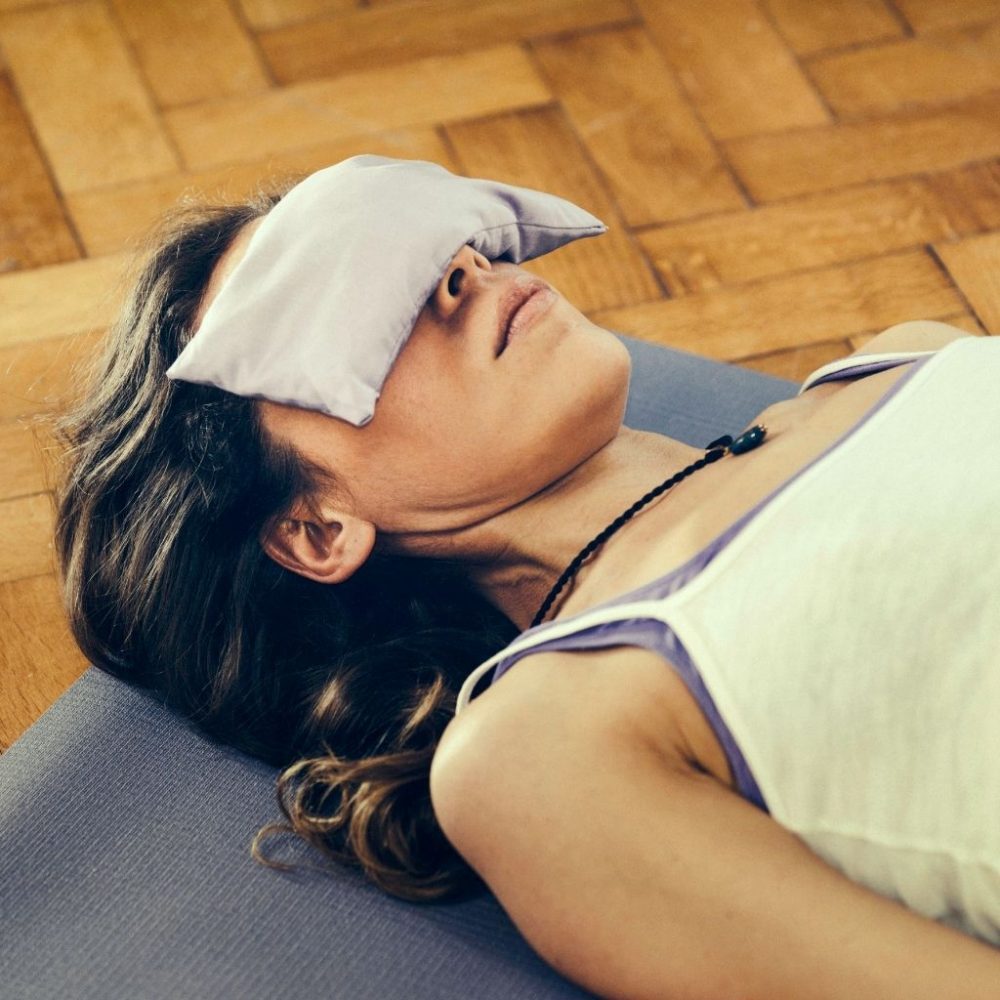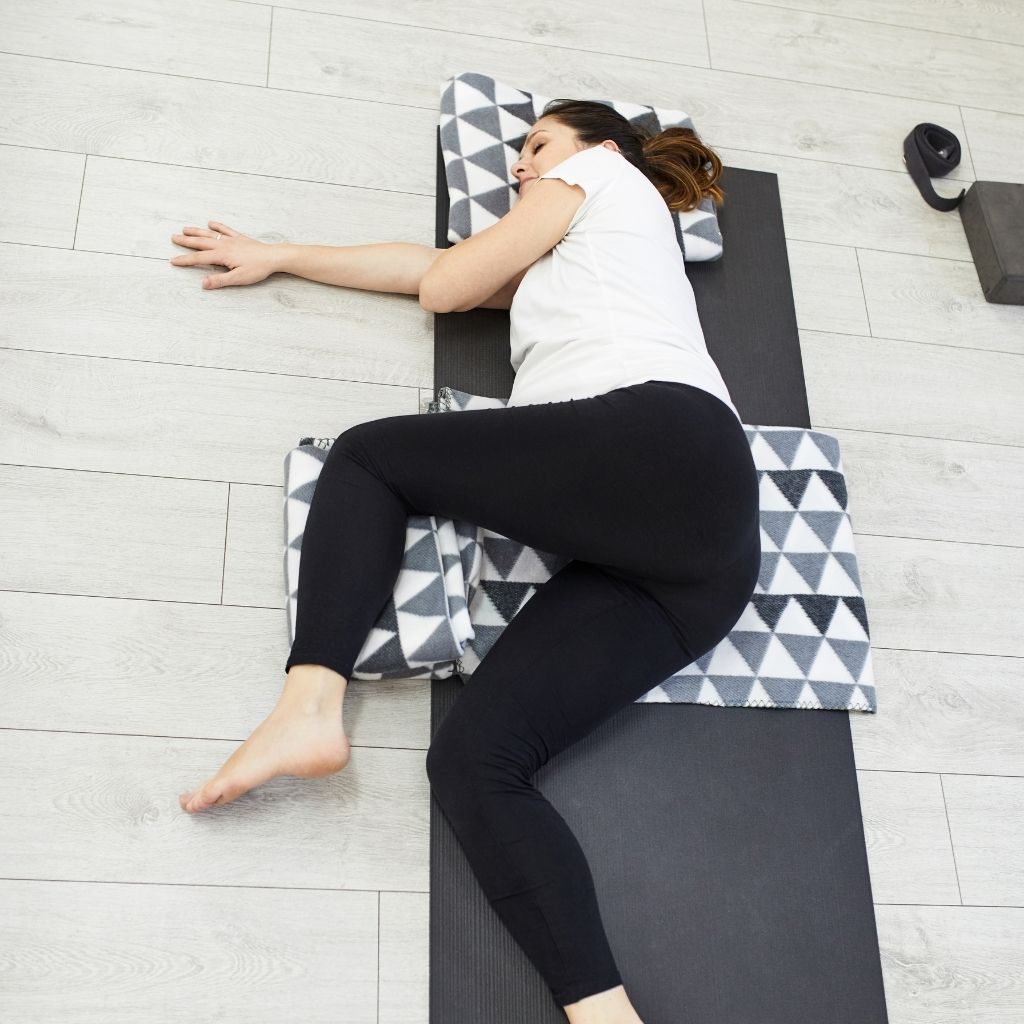Can Yoga Nidra Replace Sleep? (All You Need to Know)
Yoga Nidra can’t replace good old-fashioned sleep. It only helps create an optimal sleeping environment. Thus, you can fall asleep faster, stay asleep longer, and wake up feeling great.
Moreover, it can be practiced as an alternative to sleeping pills or other sleep aids because it helps you relax, focus on breathing exercises, and find stillness before falling asleep.

Yoga Nidra is a calming, awareness-based practice with roots in traditional Indian yoga and Buddhist mindfulness methods.
This meditation technique is scientifically proven to improve sleeping habits, anxiety, and stress. You can also strengthen your mind-body connection with practice!
This article answers some common questions about Yoga Nidra and sleep so that you can understand its true purpose and benefits.
Let’s dive in!
Does Yoga Nidra reduce sleep?
Although Yoga Nidra helps you fall asleep faster, it doesn’t reduce the sleeping time. Yoga Nidra is the practice of guided relaxation to train your mind on how to disengage from surroundings for better sleep. This form of meditation will take you into a peaceful realm, where you’re on the edge of consciousness and unconsciousness.
According to some experts, Yoga Nidra for forty-five minutes is equal to three hours of sleep. So if you’re feeling under-rested and have a long day ahead, Yoga Nidra can help you stay alert and active.
However, it can’t replace the benefits of seven to eight hours of daily sleep.
One study shows that Yoga Nidra can’t reduce sleep time!
However, you will achieve a deep state of awareness when your mind becomes still. Through this practice, you can let go of your thoughts and surrender to relaxation.
Nidra heals your body through deep restorative sleep. It also calms your mind by releasing resistance and tension.
This leads to improved sleep quality, increased vitality and creativity, higher self-esteem, more energy during the day, and less anxiety about daily life challenges.
In a nutshell, the benefits of Yoga Nidra depend on your intention of practicing it.
While Yoga Nidra doesn’t reduce sleep time, it helps you organize your thoughts by focusing on a point.
Your thoughts will eventually turn into something more abstract and surreal.

How is Yoga Nidra different from normal sleep?
Yoga Nidra creates hypnotic energy that keeps you between consciousness and unconsciousness simultaneously. As opposed to normal sleep where you become totally unconscious.
During sleep, waves of electrical activity cycle as you transition from light sleep into a deep sleep and eventually dream states (REM).
During these states, you will experience all sorts of images, memories, vivid dreams, and even out-of-body experiences.
Yoga Nidra is not the same as deep sleep. During your practice, you may experience slower brainwave frequencies, however, you can still hear your guide or yourself thinking internally.
Yoga Nidra doesn’t involve transcending consciousness like during dreaming in REM; you are fully aware yet deeply relaxed on the surface of your consciousness.
Let’s see how Yoga Nidra is different from normal sleep in detail below.
1. You don’t lose consciousness during Yoga Nidra
Although Yoga Nidra keeps you between deep sleep and calm wakefulness, you stay aware of your surroundings. Normal sleep doesn’t work like that. You can’t hear stuff or feel anything during deep sleep. Yoga Nidra is different because you can direct your awareness to sense, touch, and listen.
This mental awareness creates a space between you and your thoughts. As a result, you can identify your fears, anxieties, and beliefs more clearly.
Yoga Nidra awakens you to your life on levels you have never experienced before.
You will discover how all the parts of you – your body, emotions, thoughts, and feelings – are connected within you and with each other even though they appear separate in daily life.
Your inner wisdom will awaken, so you can make choices and decisions you are happy with.
When your senses come together with more focus on one thing, you can create space for new knowledge and understanding about yourself to emerge naturally during Yoga Nidra.
The answers to questions you currently have may come to you more clearly.
Moreover, the information you receive is always in the correct order at this moment. It guides you on your journey of self-discovery and transformation.
In normal sleep, you often dream but don’t know about it. In Yoga Nidra, you become more aware of your thoughts, feelings, and dreams.
It becomes easier to distinguish between reality and imagination as you consciously experience your sleeping state – you feel you are part of your dream instead of being in a passive observer role only.
2. You can connect to your true self with Yoga Nidra
With practice, you will find it easier to hold onto consciousness as you go deeper so that your consciousness becomes more extensive than before. In doing so, you will discover new information about yourself each time you do Yoga Nidra that helps you get closer to your life purpose. Alternatively, sleep just recharges your body and prepares you for another day.
The way you experience your body right now, what you perceive to be true about the world, and how you interpret yourself forms through the primary filters of your subconscious mind: thoughts, feelings, and beliefs.
The ability to change these filters through yoga Nidra depends on the awareness you can keep while you fall deeper into relaxation.
3. Yoga Nidra sessions are shorter than sleep
Yoga Nidra sessions last for an hour at maximum. While you can go for longer durations, they are still not equivalent and as beneficial as a good seven to eight hours of sleep.
Your body heals and undergoes essential chemical changes during sleep. Therefore, a Yoga Nidra session of 45-60 alone isn’t enough to stay healthy.
It depends on your goal, but you should take a break after 30-60 minutes of practicing Yoga Nidra, or you’ll burn out your brain.
If you try to push yourself past this point, you may have difficulties concentrating and completing your daily activities.
So always listen to your body when it comes to how long you should practice Yoga Nidra!
You should also never reach the point where you feel bored, tired, or restless.
4. You need practice and equipment for Yoga Nidra
Yoga Nidra requires practice and consistent meditation to master. You will also need pillows, bolsters, and other props to gain maximum benefits. Conversely, sleeping is a natural phenomenon and a built-in repair mechanism for your body. If you’re healthy, you can fall asleep naturally without any difficulty or special equipment.
You can take special Yoga Nidra classes that provide essential equipment to ensure a calm environment, so you can focus better and feel relaxed.
Also, you need to find a qualified and experienced Yoga Nidra specialist to train you for better sleep.
Generally, Yoga Nidra classes arrange for pillows, blankets, blocks, bolsters, etc. Moreover, you can use posture-friendly equipment for comfort.

Reasons why sleep cannot be replaced by Yoga Nidra
Yoga Nidra can’t replace sleep because specific chemical processes and hormonal secretions only occur during sleep. For instance, collagen and growth hormone production enhance while you’re unconscious to keep you fresh and healthy.
Here are some reasons that show why Yoga Nidra can’t replace sleep:
1. Your skin rejuvenates while sleeping
Since Yoga Nidra doesn’t induce complete unconsciousness, it can’t promote skin rejuvenation. Restful daily sleep keeps your skin healthy and beautiful. Sleep can help reduce inflammation and balance hormones, resulting in fewer breakouts and a more even skin tone. When you’re unconscious during sleep, your body produces collagen to reduce fine lines and wrinkles. It also keeps your skin well-hydrated and glowy.
Your body needs sleep to heal and regenerate. Insufficient sleep could weaken your immune system, causing inflammation and other issues.
As a result, you may experience breakouts if you’re sleep-deprived.
Your skin rejuvenates to recover from sun exposure, pollution, and other environmental factors that may cause damage over time.
Sleep helps the skin repair any damage done during the day, so it can heal without leaving scars or wrinkles behind!
2. Hormone regulation during sleep
Although Yoga Nidra can help you relax and lower anxiety, it doesn’t produce growth and repair hormones. Research shows that growth hormone levels are increased during sleep, which helps with muscle recovery, fat burning, and proper brain function.
There are fewer chances of internal repair with a Yoga Nidra session as your mind is not entirely unconscious.
3. Sleep improves memory
Proper sleep makes sure that critical life-sustaining functions of your brain do not come to a standstill. The brain takes lots of information from your senses, memorizes them, and makes sense out of the data. Without sleep, you will struggle to stay alert at all times.
The need for sleep is deeply ingrained in you. It is driven by the “biological clock” and makes you sleepy at regular intervals throughout the day.
Practicing Yoga Nidra retains your brain so you can turn on each part while you need it.
For example, you can relax your body without falling asleep.
You also learn how to create a pre-sleep state so you can quickly fall asleep when you want to.
Conclusion
Although Yoga Nidra can help with chronic insomnia, anxiety, and depression, it can’t replace sleep as your body isn’t fully immersed in a sleeping cycle. Your organs and other musculoskeletal tissues repair themselves while you’re asleep. Moreover, there are certain biological and chemical reactions your body undergoes when you’re unconscious during sleep. So while yoga Nidra helps improve your sleeping habits, it isn’t a substitute for sleep.
Do you have trouble sleeping?
Are you feeling anxious in your day-to-day life?
Do you need a break from the stress of work and demanding deadlines?
Then, kick back and experience the inner workings of your mind with Yoga Nidra – a glorious guided relaxation practice.
This technique can elicit an altered state of consciousness through slow brainwave frequencies that bring peace and clarity. You will drift off into deep sleep before you know it!

